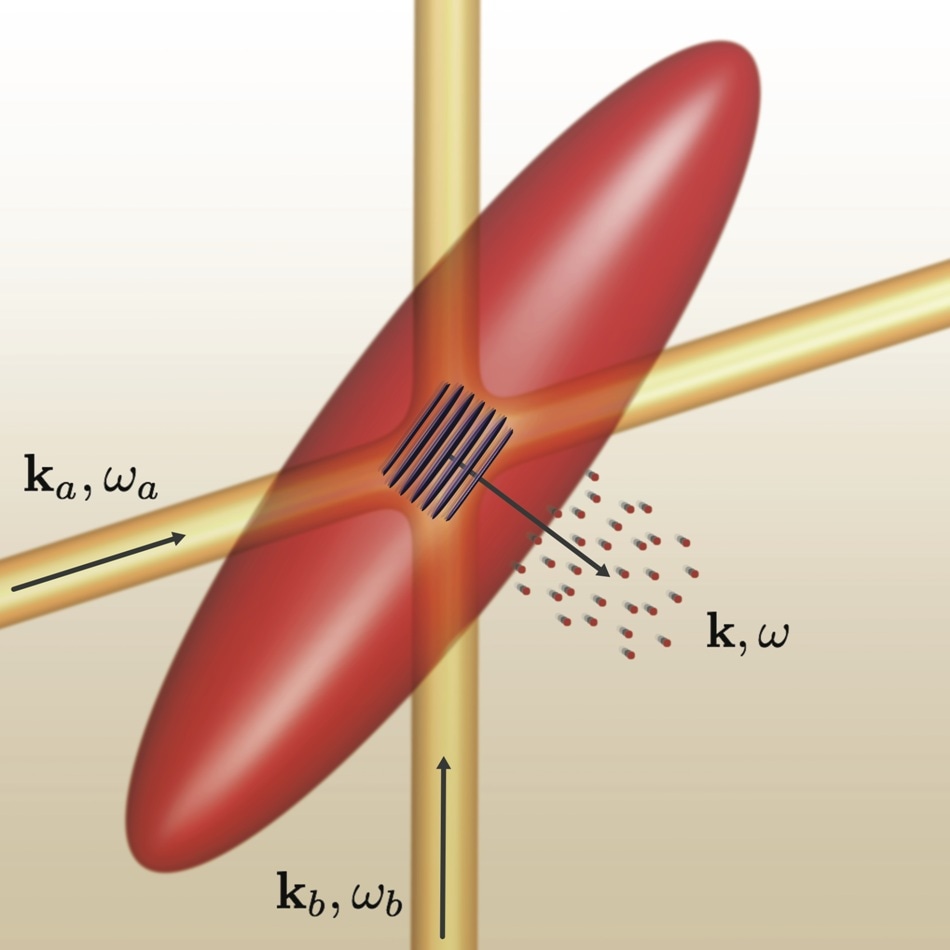May 29 2019
A new study released by a FLEET/Swinburne overcomes an age-old debate of what exactly occurs at the microscopic level when matter changes into a superfluid or superconducting state.
 Two laser beams are focused to intersect in the middle of a cloud of lithium atoms, causing some atoms to be scattered out. (Image credit: Sascha Hoinka, Swinburne University of Technology)
Two laser beams are focused to intersect in the middle of a cloud of lithium atoms, causing some atoms to be scattered out. (Image credit: Sascha Hoinka, Swinburne University of Technology)
As the system was cooled below the superfluid transition temperature, correlations between atomic pairs in an ultra-cold gas were observed to grow abruptly instead of appearing slowly at higher temperatures, as predicted by certain theories.
At the Ultra-cold Atomic Gas laboratory of the Swinburne University of Technology, experiments were performed using gases of lithium atoms that were cooled to below 100 nano-Kelvin temperatures, which are less than a millionth of a degree above Absolute Zero.
Unlocking pairing mechanism of Fermi-gas systems
The latest study reveals important functions of a state of matter called a “Fermi gas.” The free movement of electrons in an electrical conductor (for instance, in a traditional electric current), or neutrons and protons present inside a nucleus are examples of the Fermi gas. More-exotic states, like the “superfluid” of neutrons inside a neutron star, or electrons in superconductors are other types of the Fermi gas systems.
One of the open questions about strongly interacting Fermi-gas systems has been the role of pairing. Our study demonstrated that, at the superfluid transition temperature, pair-correlations increase abruptly, rather than gradually—as has been predicted by some theories.
Chris Vale, Professor, FLEET CI
Such an observation was determined by measuring a universal parameter, called the “contact parameter.” This parameter measures the possibility of locating a pair of atoms that is extremely proximal to one another, and is robustly improved when atoms create pairs.
A similar research, performed by the team of Martin Zwierlein at the Massachusetts Institute of Technology and published successively with the Swinburne team’s paper, discovered almost similar results, utilizing an entirely different technique. The experiments, carried out by MIT and Swinburne University, represent a major development in understanding the pairing in Fermi superfluid systems with powerful interactions between particles.
Experimental results point to correct theory
A unitary Fermi gas of lithium-6 atoms was generated by the Swinburne group, which then examined the system by determining the momentum imparted to the atoms by two crossed laser beams, which, in turn, disturb the gas in a well-defined way. Based on this data, the researchers obtained the contact parameter, which showed a sudden increase of about 15% as the reduced below the superfluid transition point.
Hypothetical attempts to compute the temperature evolution of the contact parameter are extremely challenging and have produced highly different predictions that rely on the model meant for interacting fermions. The experiments performed by MIT and the Swinburne University support the Luttinger-Ward theory, which states that pairing turns on suddenly at the superfluid transition temperature.
The study
The study titled, ‘Contact and sum-rules in a near-uniform Fermi gas at unitarity’ was recently published in Physical Review Letters.
In addition to the Australian Research Council, the authors thank MIT’s Mukherjee and Zwierlein, as well as theoretical researchers Drut (USA), Zwerger (Germany), Werner (France), Strinati (Italy), and Goulko (Israel) for providing access to their data and valuable discussions.
Ultra-cold gas studies at FLEET
Ultra-cold atoms are generally used by researchers for studying quantum systems, due to the potential to seamlessly “tune” atomic interactions. Currently, quantum gases of ultra-cold, neutral atoms are making it possible to expose the basic physics of Fermi systems, usually revealing phenomena that cannot be readily accessed in other types of systems.
Boosting the interaction strength between fermionic atoms will allow experiments to investigate the “unitary” limit, where the behavior of atoms is anticipated to uncover universal traits of interacting fermions that can possibly improve one’s interpretation of Bose-Einstein condensation and superconductivity.
Fundamental discoveries made from experiments such as these can help guide FLEET’s quest to develop 2D materials that conduct electrical current without dissipating energy.
Chris Vale, Professor, FLEET CI
At the Swinburne University of Technology, Chris heads FLEET’s studies of quantum gases where his laboratory regularly cools atomic gases to temperatures nearing Absolute Zero. In this range of temperature, quantum behaviors that are often found only at the microscopic level become noticeable at the macroscopic level.
Chris is one of over a 100 FLEET researchers, all encouraged by one major challenge—that is, to lower the energy utilized in information and communication technology (ICT), which is already responsible for a minimum of 8% of electricity use in the globe and is increasing by two-fold every 10 years.
The ARC Centre of Excellence in Future Low-Energy Electronics Technologies (FLEET) will create systems, where electricity flows with the least resistance and thus minimal wasted dissipation of energy, and also devices, where this “dissipationless” electric current can be turned on and off, if required. Such devices will give way to new, breakthrough communications technologies and electronics with extremely low energy consumption.